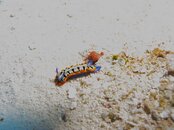They are there, you just have to know where to look for them. The caribbean nudi's tend to be smaller. I have seen them all over the caribbean, now that I know what I am looking for. The best thing you can do is learn about their behavior and habitats. A great book for that is Caribbean Sea Slugs. I use it as a reference a lot.
Are sea slugs nudibranchs? Or is the opposite true? I have one photo of a sea slug that I took on my last trip to Cozumel, but I didn't think they were really related except at a ... er .. higher classification level? It's been many years since sixth grade biology
But I figured they were both gastropods but unrelated beyond that.
anyway, not the best shot in the world (I'm still very much an amateur), but here goes:





